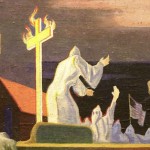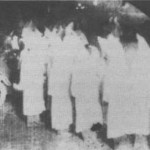It is a painful but persistent fact of Indiana history that the Ku Klux Klan permeated every level of state government in the 1920s. With David C. Stephenson, at its helm, the Indianapolis chapter swelled to 28,000 members—the country’s largest—by 1923.
The state legislature and many city halls were staffed with members of the so-called “Invisible Empire” by the time fellow Klansman Ed Jackson was elected to the governorship in 1924.
“The organizers of the Klan,” The Baltimore Sun reported, “were enrolling citizens so fast that they ran out of nightgowns three times.”
In 1925, Grand Dragon Stephenson was charged with the rape and murder of a female state employee. The scandal laid waste to the Klan’s self-appointed role as a keeper of morality, and Stephenson’s ensuing testimony led to the arrest of many state politicians for violations of the Corrupt Practices Act.
The Indianapolis Times won a Pulitzer Prize in 1928 for its role in uncovering the scandals and corruption, and for breaking up the Klan’s stranglehold on the state.
It has been argued, however, that the Klan had already disintegrated before the publication of the Times exposé. Much earlier in the decade, a Muncie newspaperman was waging his own editorial battle against the oppressive organization.
George Dale, the founding editor of The Muncie Post-Democrat, had published his first attack on the Klan in 1922. Dale charged that Delaware County Circuit Court Judge Clarence Dearth was a Klansman who stacked juries with those of his ilk and gave light sentences to Klansmen convicted in his court.
Dearth subsequently found Dale in contempt of court and the editor spent his life savings defending his First Amendment right to print factual information, a story picked up by the national press.
Republican and Democratic newspapers across the country lauded Dale for his heroism, and readers nationwide contributed to his legal defense fund.
By 1927, The Post-Democrat’s circulation had swelled to 18,000—more than seven times its 1923 readership. By 1928, Klan membership statewide had dwindled to 7,000 from an estimated 300,000 at its peak.
The following year, Dale was elected mayor of Muncie.
Sources include:
Ron F. Smith, “The Klan’s Retribution Against an Indiana Editor: A Reconsideration.” The Indiana Magazine of History, 106 (December 2010) 381-400.






















